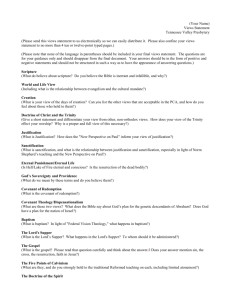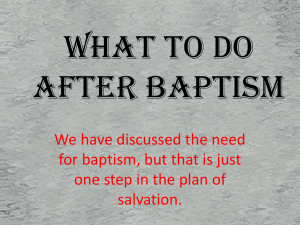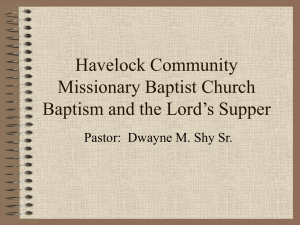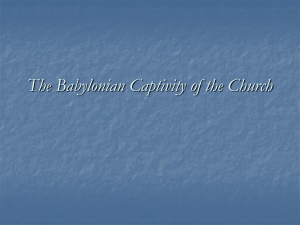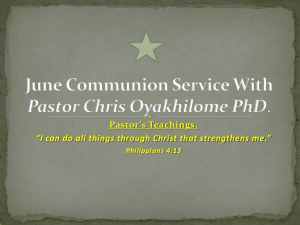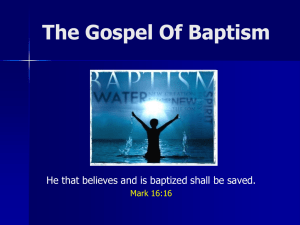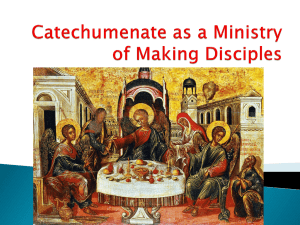Baptism and Eucharist - An Unworthy Servant
advertisement
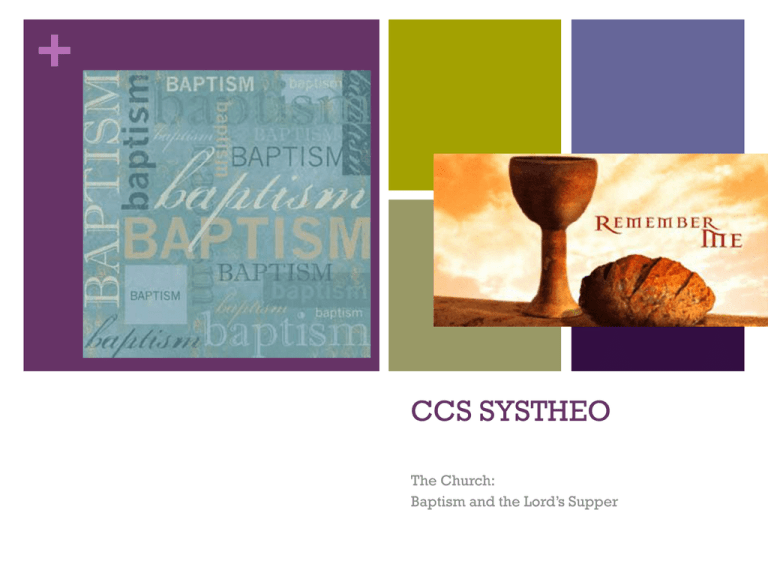
+ CCS SYSTHEO The Church: Baptism and the Lord’s Supper + Baptism + Baptism Views Means of Grace Covenant Sign or Seal Picture of Salvation + Also categorized . . . PedoBaptism – Baptizing Children into Church CredoBaptism – Baptizing believers as the Church + Baptism as a Means of Grace PedoBaptists Considered a sacrament, rather than an ordinance Catholic, Orthodox, Lutheran* Either God’s doing through the Church authority or God’s doing more nebulous – but mystical in sacrament – God’s doing through procedure Generally approached from the biblical texts regarding entire households being baptized (Acts 11, 16 & 18) + Baptism as Sign & Seal of the Covenant PedoBaptists* Considered a sign, but a calling to the faithfulness to the Covenant It is a promise of grace, but only through obedience to the Covenant – yet, with overlap to sacramentalists views Much like the sign of circumcision for the covenant in OT, so is baptism in NT Approaches to passages like Col. 2:11-12, as well as household passages again in Acts to support. + Baptism as a picture of Salvation CredoBaptists Not a sacrament, but an ordinance Has no merit whatsoever, but is an act of obedience, confession and experience Only for those who have exercised faith in the Gospel unto salvation and therefore happens after Matthew 28:19-20 and Ethiopian Eunuch was baptized after belief; also thief on Cross promised Paradise with no baptism – not required. + A couple notes on “mode” Immersion Baptize is a transliterated word from the Greek, baptizo It is the meaning of the word baptizo in Greek – to dip or immerse See even mundane uses – John 13:26 (dipped) Pouring (Affusion) Pouring water over someone is related to the Pouring out of the Spirit. Considered an option in the early Church (See next Slide) Sprinkling (Aspersion) And concerning baptism, thus baptize ye: Having first said all these things, baptize into the name of the Father, and of the Son, and of the Holy Spirit, in living water. But if thou have not living water, baptize into other water; and if thou canst not in cold, in warm. But if thou have not either, pour out water thrice upon the head into the name of Father and Son and Holy Spirit. But before the baptism let the baptizer fast, and the baptized, and whatever others can; but thou + shalt order the baptized to fast one or two days before. -Didache ch. 7, from Ante-Nicene Fathers + A couple notes on “mode” Immersion Baptize is a transliterated word from the Greek, baptizo It is the meaning of the word baptizo in Greek – to dip or immerse See even mundane uses – John 13:26 (dipped) Pouring (Affusion) Pouring water over someone is related to the Pouring out of the Spirit. Considered an option in the early Church (See next Slide) Sprinkling (Aspersion) Often related to Ezekiel 36:25 25 ”I will sprinkle clean water on you, and you shall be clean from all your uncleannesses, and from all your idols I will cleanse you.” + To Clear things up . . . Jesus saves – and only Jesus. Acts 4:11-12 How that salvation is applied is in question The flow of salvific history/theology is also in play The Bible must be the final authority + The Lord’s Supper + Lord’s Supper Views Transubstantiation Consubstantiation Commemoration + Other Categories Roman Catholic (Transubstantiation) Lutheran (Consubstantiation) Reformed (Sacramental) Zwinglian (Commemoration) + Roman Catholicism transubstantiation. A term in Roman Catholic theology meaning “essential change,” the belief that by the power of God at the consecration in the Mass, the bread and wine change substance into the actual substance of Jesus’ body and blood, even though they seem to retain their natural characteristics. + Lutheranism Martin Luther taught that the body and blood of the Lord is present “in, with and under” the actual bread and wine. consubstantiation. + Commemoration Commemorialism. Originating with Ulrich Zwingli, a view of the Lord’s Supper that sees the rite as symbolic, as representing (or memorializing) Christ’s self-giving on the cross (together with his last supper with the disciples). Commemorialists believe that Christ’s presence is not localized in the communion elements but within the gathered community of believers. Memorialists consider the word is in Christ’s words, “This is my body. . . . This is my blood” (Mk 14:22, 24) to be figurative, so that it means “signifies” or “represents.” Hence by this phrase Jesus was not referring literally to his physical body and blood but was indicating that the physical elements are symbols of his life that would be given for them. The Lord’s Supper is a reminder of the death of Christ and of its sacrificial character in + our behalf, a symbol of our vital connection with the Lord, and a testimony to His second coming. + A Focused and Sobering Passage 1 Corinthians 11:23-32 + And can it be that I should gain an interest in the Savior's blood! Died he for me? who caused his pain! For me? who him to death pursued? Amazing love! How can it be that thou, my God, shouldst die for me? Amazing love! How can it be that thou, my God, shouldst die for me? + CCS SYSTHEO The Church: Baptism and the Lord’s Supper
